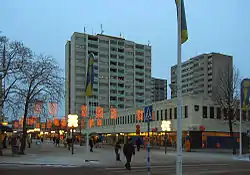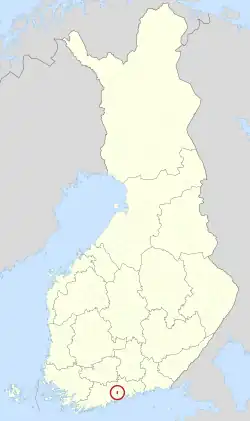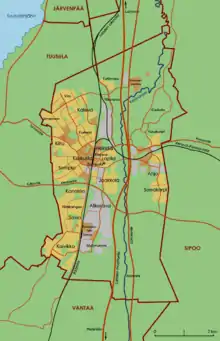Kerava
Kerava (Finnish pronunciation: [ˈkerɑʋɑ]; Swedish: Kervo) is a town and municipality within the Uusimaa region of Finland. The municipalities of Vantaa, Sipoo and Tuusula are adjacent to Kerava, which is part of the Helsinki metropolitan area.[5]
Kerava
Kervo | |
|---|---|
Town | |
| Keravan kaupunki Kervo stad | |
 Kerava town centre | |
 Coat of arms | |
 Location of Kerava in Finland | |
| Coordinates: 60°24′N 025°06′E | |
| Country | |
| Region | Uusimaa |
| Sub-region | Helsinki sub-region |
| Township | 1924-1970 |
| City | 1970- |
| Government | |
| • Mayor | Kirsi Rontu |
| Area (2018-01-01)[1] | |
| • Total | 30.79 km2 (11.89 sq mi) |
| • Land | 30.62 km2 (11.82 sq mi) |
| • Water | 0.17 km2 (0.07 sq mi) |
| • Rank | 309th largest in Finland |
| Population (2023-10-26)[2] | |
| • Total | 38,204 |
| • Rank | 30th largest in Finland |
| • Density | 1,247.68/km2 (3,231.5/sq mi) |
| Population by native language | |
| • Finnish | 84.2% (official) |
| • Swedish | 1.2% |
| • Others | 14.6% |
| Population by age | |
| • 0 to 14 | 16.3% |
| • 15 to 64 | 63.8% |
| • 65 or older | 19.9% |
| Time zone | UTC+02:00 (EET) |
| • Summer (DST) | UTC+03:00 (EEST) |
| Climate | Dfb |
| Website | www.kerava.fi |

The town has a population of 38,204 (26 October 2023)[2] and covers an area of 30.79 square kilometres (11.89 sq mi) of which 0.17 km2 (0.066 sq mi) is water.[1] The population density is 1,247.68 inhabitants per square kilometre (3,231.5/sq mi). Kerava is the 30th largest municipality in terms of population, but the 5th smallest municipality in terms of area in Finland (and the second smallest in the Uusimaa region after Kauniainen). However, it is also the third most densely populated area in the sub-region after Helsinki and Kauniainen. The municipality is unilingually Finnish.
The Sinebrychoff brewery operations are based in Kerava.[6] There is also a well-known prison in the town (Keravan vankila),[7] which includes 94 places in the open prison ward.
History
Until the Middle Ages, Kerava was a wilderness, until two villages, Ylikerava ("Upper Kerava") and Alikerava ("Lower Kerava"), were created along the Kerava River (Keravanjoki). The first signs of established village settlement date back to the 1440s. Kerava was annexed to Tuusula when the Tuusula parish was founded in 1643. In 1862, the railway between Helsinki and Hämeenlinna was opened, which quickly brought industry to agricultural Kerava; the carpentry factory in Kerava was established in 1908, and the wood industry became an important factor in the development of the town. The coat of arms designed by Ahti Hammar features a woodworking joints made by a carpenter.[8]
In 1924, Kerava was separated from Tuusula as its own township. At that time, it had a population of about 3,000. Originally, it also included part of the Korso area, and Korso railway station was also located in the township area. However, from 1954 onwards, the entire Korso was annexed to the then Helsinki Rural Municipality.[9] During the peak periods of the late 1960s and 1970s, the population almost doubled due to immigration and good transport connections, and new suburbs were created in Kurkela, Kilta and Untola. Kerava was officially granted town rights in 1970.[8]
Geography
Kerava is located in the north of the Capital region, 27 kilometres north of Helsinki. The city is crossed by the (Helsinki-) Kerava–Lahti railway line and the Lahdenväylä motorway and the Keravanjoki river. Keravanjoki is a tributary of the Vantaanjoki river. Its neighbours are Vantaa to the south, Tuusula to the west and Sipoo to the east. Kerava forms an almost uniform urban area, which can be roughly divided into the centre and Savio in the south and Ahjo in the east. The centre of Kerava is surrounded by several radial streets. A pedestrian street runs through the centre under the railway, which is said to be the longest in Finland (850 metres).
Kerava is divided into 10 neighbourhoods.
| Number | Name |
|---|---|
| 1 | Kaleva |
| 2 | Kilta |
| 3 | Sompio |
| 4 | Keskusta |
| 5 | Ahjo |
| 6 | Savio |
| 7 | Ylikerava |
| 8 | Kaskela |
| 9 | Alikerava |
| 10 | Jokivarsi |
Demographics
Population
The city of Kerava has 38,204 inhabitants, making it the 30th most populous municipality in Finland. The city of Kerava is part of the Helsinki region, which is the largest urban area in Finland with 1,576,438 inhabitants. In Kerava, 14.8% of the population has a foreign background, which is above the national average.[10]
| Year | Population |
|---|---|
| 1990 | 27,597 |
| 1995 | 29,385 |
| 2000 | 30,270 |
| 2005 | 31,544 |
| 2010 | 34,282 |
| 2015 | 35,293 |
| 2020 | 37,105 |
Languages
Population by mother tongue (2022)[10]
Kerava is a monolingual Finnish-speaking municipality. The majority of the population - 31,718 people or 84.2% - speak Finnish as their first language. In Kerava, 467 people, or 1.2% of the population, speak Swedish.[10] 12.5% of the population of Kerava have a mother tongue other than Finnish or Swedish.[10] As English and Swedish are compulsory school subjects, functional bilingualism or trilingualism acquired through language studies is not uncommon.
At least 40 different languages are spoken in Kerava. The most common foreign languages are Estonian (1.4%), Russian (1.3%), Arabic (0.5%) and English (0.4%).[10]
Immigration
| Population by country of birth (2022)[10] | ||
| Nationality | Population | % |
|---|---|---|
| 32,810 | 87.1 | |
| 1,244 | 3.3 | |
| 588 | 2.9 | |
| 185 | 0.5 | |
| 167 | 0.4 | |
| 165 | 0.4 | |
| 163 | 0.4 | |
| 146 | 0.4 | |
| 120 | 0.3 | |
| 117 | 0.3 | |
| 97 | 0.3 | |
| Other | 1,702 | 4.5 |
In 2022, there were 5,586 persons with a migrant background living in Kerava, or 14.8% of the population.[note 1] The number of residents who were born abroad was 4,866, or 12.9% of the population. The number of persons with foreign citizenship living in Kerava was 3,958.[12] Most foreign-born citizens came from Estonia, the former Soviet Union, Turkey and Thailand.[10]
The relative share of immigrants in Kerava's population is above the national average. Moreover, the city's new residents are increasingly of foreign origin. This will increase the proportion of foreign residents in the coming years.
Religion
In 2022, the Evangelical Lutheran Church was the largest religious group with 55.7% of the population of Kerava. Other religious groups accounted for 3.2% of the population. 41.1% of the population had no religious affiliation.[10]
Transport
Kerava has two railway stations, Kerava Central Railway Station and Savio station. The Kerava Central Railway Station is an interchange station, with connections from the main track from Helsinki to Riihimäki to the tracks to Lahti and Porvoo. The Helsinki Airport (HEL) is located about 15 kilometers to the southwest of the city by car. It is 32 kilometres (20 mi) along Highway 4 (E75) from Kerava to the city center of Helsinki.
The city of Kerava joined Helsinki Regional Transport Authority (HSL) in 2010.
Culture
Politics
Results of the 2019 Finnish parliamentary election in Kerava:
- Social Democratic Party 19,8%
- National Coalition Party 19,3%
- Finns Party 19,0%
- Green League 12,9%
- Left Alliance 8,6%
- Centre Party 6,8%
- Movement Now (common list of Uusimaa) 4,4%
- Christian Democrats 3,2%
- Blue Reform 1,9%
Notable people from Kerava
- President J. K. Paasikivi (1870–1956), lived in Kerava since 1917 to the 1940s
- Hanna-Maria Seppälä (b. 1984), Finnish freestyle swimmer
- Volmari Iso-Hollo (1907–1969), Olympic medalist
- Jean Sibelius (1865–1957), Finnish composer
- Väinö Bremer (1899-1964), Finnish Olympic medalist biathlete and pilot died here in a plane crash
See also
Notes
- Statistics Finland classifies a person as having a "foreign background" if both parents or the only known parent were born abroad.[11]
References
- "Area of Finnish Municipalities 1.1.2018" (PDF). National Land Survey of Finland. Retrieved 30 January 2018.
- "Preliminary population statistics 2023, September". StatFin. Statistics Finland. Retrieved 26 October 2023.
- "Demographic Structure by area as of 31 December 2022". Statistics Finland's PX-Web databases. Statistics Finland. Retrieved 6 September 2023.
- "Population according to age (1-year) and sex by area and the regional division of each statistical reference year, 2003–2020". StatFin. Statistics Finland. Retrieved 2 May 2021.
- Pro Grani – Kuntakaupunkirakenne
- "History of the Company". Sinerbrychoff (in Finnish). Archived from the original on August 15, 2018. Retrieved July 12, 2021.
- Kerava Prison – R/SE (in English)
- "Historiaa" (in Finnish). Town of Kerava. Archived from the original on February 19, 2007. Retrieved July 1, 2021.
- "Korson kunta" (in Finnish). Korso Social Democratic Workers' Society. Archived from the original on June 1, 2015. Retrieved July 1, 2021.
- "Number of foreign-language speakers grew by nearly 38,000 persons". Statistics Finland. 31 May 2023. Retrieved 12 September 2023.
- "Persons with foreign background". Statistics Finland. Retrieved 18 September 2023.
- "Population structure 2000-2022, urban-rural classification". Statistics Finland. 26 May 2023. Retrieved 12 September 2023.
- Jaakko Kolmonen: Kotomaamme ruoka-aitta: Suomen, Karjalan ja Petsamon pitäjäruoat, p. 56. Helsinki: Patakolmonen Ky, 1988. (in Finnish)
External links
- Town of Kerava – Official website (In Finnish) Information - Official Websites (In English)
- Satellite photo of Kerava
